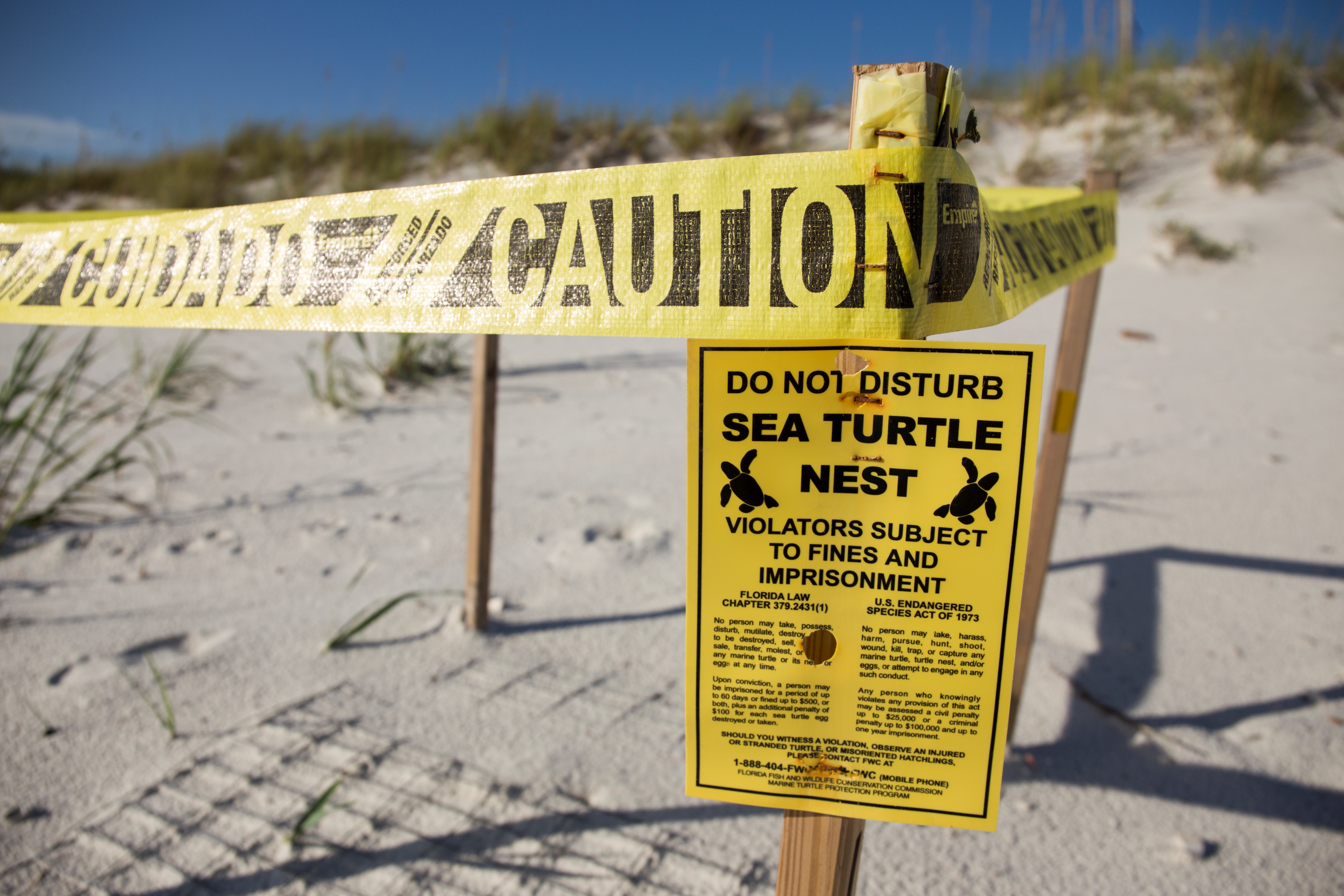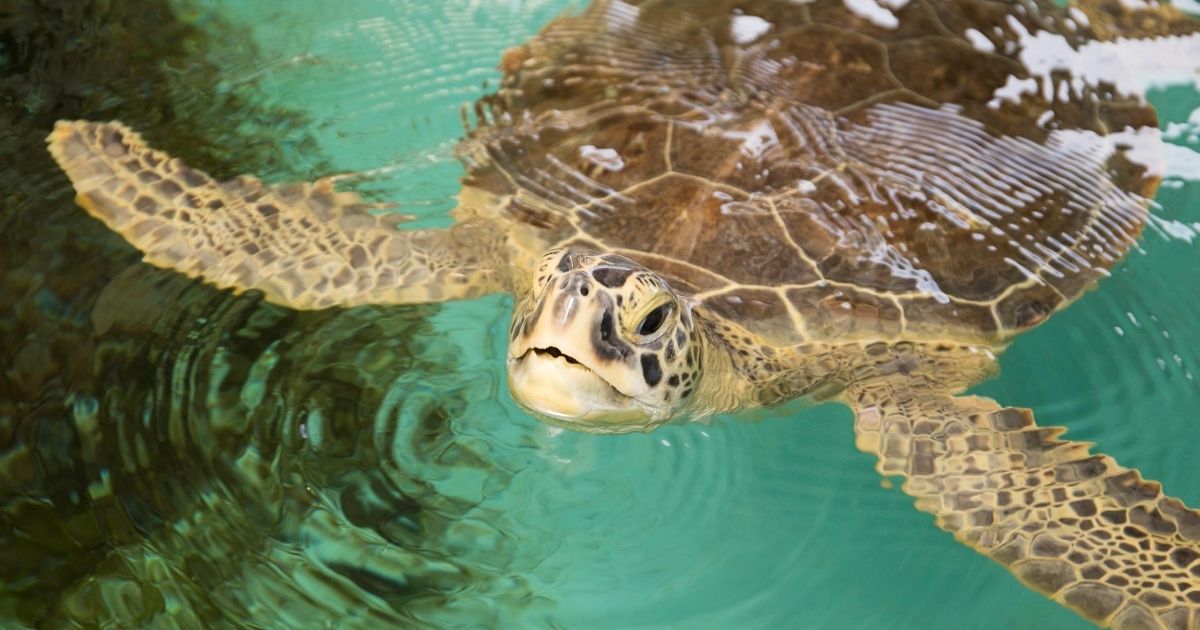Hurricane season, June through November, overlaps with sea turtle nesting season, which starts in March and runs through October in Florida.
When storms approach the coast, they can put nests in peril. Hurricane season can wreak havoc on sea turtle habitats and nests, but other factors raise even greater concern for the endangered sea turtles that nest along Florida coasts. Tory Moore and Lourdes Rodriguez asked University of Florida Institute of Food and Agricultural Sciences (IFAS) experts how hurricanes impact sea turtles and what people can do to help sea turtles year-round.
- Ken Gioeli, a UF/IFAS Extension agent specializing in natural resources and environment.
- Maia McGuire, UF/IFAS Associate Program Leader for coastal and marine Extension.
 Q: Do hurricanes have an impact on sea turtles?
Q: Do hurricanes have an impact on sea turtles?
A: (McGuire) Sea turtles have successfully dealt with hurricanes forever, but hurricanes can impact sea turtle nests in a couple of ways.
Sea turtles must breathe air. Similarly, the developing sea turtle babies must be able to breathe air while in their eggs. The female turtles lay their nests high up on the beach—above the high tide mark. This usually means that the nest will not flood at high tide. However, hurricanes can impact these nests in two ways.
- Storms may push sea water higher up on the beach than normal which can flood sea turtle nests, causing the embryos in the eggs to drown.
- Strong wave action can also cause beaches to erode, washing sand away. This can expose sea turtle eggs, leaving them prone to drying out or predation. They can also destroy the nests completely, washing the eggs into the sea where they will drown.
Q: Does sea turtle nesting season run simultaneously with hurricane season?
A: (Gioeli) You are correct that sea turtle nesting season runs throughout most of Florida’s hurricane season. Here in St. Lucie County, sea turtle nesting season is considered to be March 1 – November 15. In other parts of the state, nesting season may not start until May. Most counties designate sea turtle nesting season as ending on October 31, but researchers have shown significant hatchling activity on St. Lucie County beaches as late as November 15. Hurricane season runs June 1 – November 30. So, as you can see, hurricanes and tropical storm activity are direct threats to sea turtle nests in Florida.
Q: What impacts can hurricanes have on sea turtle populations?
A: (McGuire) Even though some hurricanes may destroy seemingly large numbers of nests, turtles lay many nests across large geographic areas, so this helps reduce the potential impact a hurricane can have on the entire sea turtle population. Coastal development, which reduces the amount of suitable nesting area for sea turtles, is probably a much bigger concern than hurricane season.
Q: What are a few highlights you would like to share with the public that are most important about sea turtles?
A: (Gioeli) Light from oceanfront buildings, parking lots, condo interior lighting and even flashlights can harm sea turtles. Improper lighting makes nesting sea turtles vulnerable to predators.
(McGuire) Nesting sea turtles can also be easily spooked by people using flashlights when walking on the beach at night. People should not approach a nesting sea turtle as this could cause her to abandon laying her eggs and could result in the loss of that nest and its potential hatchlings (she could end up dumping her eggs in the ocean).
(Gioeli) Also, hatchlings typically emerge after dark and naturally orient toward the brightest moonlit horizon. If lights are glowing in the wrong place, hatchlings turn and move to the light source instead of the ocean. This causes hatchlings to burn up critical calories that would otherwise be needed to find safe harbor in the ocean. It also can cause hatchlings to be hit by cars, fall in swimming pools, and be eaten by predators. Oceanfront residents can use sea turtle friendly lighting in their residences without sitting in the dark. Many lighting problems are due to light placement, old lighting fixtures, wrong bulbs or lack of shielding that can be corrected. Simply drawing window shades closed at night can keep sea turtles safe by eliminating improper beachfront lighting.
(McGuire) There are only seven different species of sea turtles in the world, and five of those can be found in Florida’s coastal waters. All sea turtle species found in Florida are on the Endangered Species List and are therefore protected.
(Gioeli) If people see sea turtles in danger, they can call 888-404-FWCC (3922) and get instructions. They should be prepared to report the closest beach access point and nature of the problem.
Q: What can beachgoers do to help sea turtles?
A: (Gioeli) There are practices that can help keep our beaches sea turtle friendly. Education is a huge part of the solution. Here in St. Lucie County, I co-chair the Sea Turtle Friendly Beaches committee and we regularly discuss sea turtle-related issues. Our committee has created a list of practices that we encourage beachgoers to learn about.
These practices were developed into a UF/IFAS infographic entitled “Give sea turtles a safe path” that can be purchased for use in public areas such as oceanfront hotel lobbies and high-rise condo lobbies. It depicts practices such as use of sea turtle friendly lighting, taking down sandcastles and filling in holes dugout by beachgoers, making sure pets do not dig up nests, putting away beach furniture and leaving sea turtles alone when they are on the beach.
(McGuire) People should also pick up and reduce trash. Even when not at the beach, people should never release balloons as many of them end up in the ocean and sea turtles will eat them thinking they are food. All of these recommendations apply throughout the nesting season and beyond.
By Tory Moore and Lourdes Rodriguez, University of Florida Institute of Food and Agricultural Sciences (UF/IFAS)





